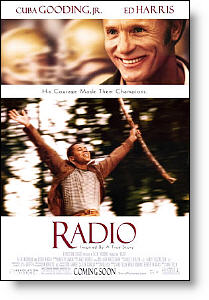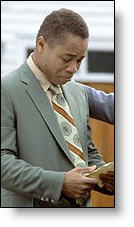Interview with the cast and crew of “Radio” (2003)
by Chris Monroe
Staff Writer
See our REVIEW of “Radio”

It was ladies first in the interviews in New York City prior to the opening of the film “Radio.” After speaking with actress and fellow believer in Christ, Sarah Drew (Mary Helen Jones), the interviews followed with actor Cuba Gooding Jr. (“Radio”) and concluded with director Mike Tollin.

Sarah Drew said she has performed in one or two plays a year since about age 5, and is making her big screen debut with the feature film “Radio.” Drew studied theatre at the University of Virginia and has recently performed in the Broadway show “Vincent and Brixton”, which she traveled to London with prior to the opening of “Radio.” Now at age 22, Drew seems to be on her way to a solid acting career, while maintaining a healthy view of life.
Drew states that her parents have been a huge support and influence for her. With her dad as a minister, her parents provided great examples and taught her, for example, that her worth is not based in what she does. Beyond the faith instilled in her by her parents, Drew says she was also able to mature in her spiritual walk through times spent at a camp called FOCUS (Fellowship of Christian Universities). It was also at this camp where she met her husband, who is currently a divinity student at Yale.
I asked Sarah if there were any scenes that were left out of the final cut of the film that she would have liked to see kept. She immediately responded by saying it was the church scenes. Currently there is only one brief church scene, but it seems there were several more that were shot. Coincidently, the church they used to film these scenes in was one that Sarah attended regularly during the 11-week shoot and really got to know some of the people there.
Before taking on any project, Drew explained that her and her husband pray about which scripts she should do. Her desire is to use the talents she believes God has given her, and to use these talents to honor Him. Furthermore, Drew’s agent knows her and knows what things she will and won’t do, so they work together to find the right projects for her.
One of the actresses Drew most respects is Kate Blanchet. The reason Drew looks up to her is because of the diversity of roles Blanchet takes. But aside from her talent, Drew also respects Blanchet’s strong marriage. In an article she read about Blanchet, Drew relays how Blanchet and her husband always travel together. In similar fashion, Drew’s husband flew to South Carolina every weekend for 11 weeks to see Drew while she was shooting “Radio” so they could be together.
Although Drew has not met Kate Blanchet, she did find another “hero” in actor Ed Harris while on the set of “Radio,” and had nothing but good things to say about him. She emphasized his humility and how he helped her as a newcomer to the medium. In one instance, prior to an emotional scene, Ed Harris improvised with Sarah so she could get to the place she needed to be emotionally. Once she was there, they shot her scenes. Ed Harris did this for her benefit, and for the production as a whole. Drew stressed what a team player Harris really is and how he always gives 110%—even when the camera is not on him.
Speaking to aspiring actors, Sarah says the most important thing they can do is to find out who they are. She admonishes them to invest in relationships outside of “the industry” and that listening too eagerly to criticism or even praise can be a detriment. Acting should be a part of your life, but it should not be all of it. It seems she also applies these things to her own life.
Cuba Gooding Jr. viewed videotapes of the real James Robert Kennedy (otherwise known as “Radio”) and even met him face to face, but the real inspiration Gooding found for playing this role was from his five-year-old son, Spencer. Gooding found that imitating his son’s frame of mind and even his actions is what worked best for him to portray “Radio.” This was acceptable to director Mike Tollin, who stated that it was more important that they capture the spirit of this loving individual rather than imitate exactly each and every mannerism.
In addition to Sarah Drew, Gooding also mentioned that there where several church scenes they shot for the film, but were not included in the final cut. He mentioned that there was a lot of good things in them and seemed disappointed that they didn’t make it in. Perhaps including these scenes could have added more dimension to Radio’s character, since Gooding commented that Radio always attends church—as well as every other social event.
Director Mike Tollin’s filmmaking career began by making documentaries and children’s shows. He also made reality shows before they became what he calls now a “weird, strange hybrid of meaninglessness.” He says he thinks he made “real” documentaries. But most notable to Tollin’s credentials is the trek he led for 12 Special Olympians up Mt. Kilimanjaro in 1990, which resulted in an Emmy Award-winning film called “Let Me Be Brave.”
Tollin expressed how much of a privilege it was for him to direct this film “Radio.” Sincerely moved after reading an article about Coach Jones by Gary Smith in Sports Illustrated entitled “Someone to Lean On,” Tollin began his pursuit of making this story of “Radio” into a feature film. This desire, which emerged in 1996, finally became a reality six years later.
Several other directors were considered before Tollin was finally chosen to direct “Radio.” Subsequently, he was the only directorial candidate that was actually flown down to South Carolina to be personally interviewed by the real Coach Jones. During his visit, he got to have dinner with the Coach and his wife and even attended church with them.
During this “interview”, Tollin was very honest with Coach Jones. Tollin frankly explained to him that he (Jones) really isn’t going to have much control of the story once the production is underway. Other directors may tell him he will, but they’re really just paying lip service. Tollin expressed that the best way he (Jones) can exercise creative control over his story is in whom they choose to tell it.
Many positive things resulted after choosing Tollin to direct the film. First of all, Tollin promised to have a screening in Anderson prior to the worldwide release of the film. Furthermore, he arranged with them to have all of the proceeds from that event donated to a charity of their choice. Economically, the town was built up, too. Some of the businesses in the town that were either dead or dying profited from the production by having their places renovated. Tollin and his guys didn’t want to be “big, bad Hollywood” and went out of their way to make sure these places were better off when they left.
But the most impressive boost to this community was Tollin’s interaction with an “old, funny-looking man” named Forrest. Tollin says it was one of his favorite highlights while making the film and also the “kismet” of the production. It began in the barbershop.
One day, Tollin and the casting director were casting extras for “Radio” and were having the people come to the barbershop. Everyone who showed up to be an extra was standing in line, but one guy, Forrest, was sitting inside, away from everyone else.
Tollin asked the casting director, “Who’s that guy?” The casting director immediately apologized to Tollin and said, “Don’t worry, we’ll tell him to go home.” “Go home? No! Bring him up here,” Tollin exclaimed. Tollin said that this gentleman, Forrest, became his star and used him as an extra in the barbershop scene, as well as other scenes of the film.
The best part about Tollin’s simple act of kindness is the attention that came to Forrest’s life. Not only did Forrest become a regular extra for the film, but the local newspaper took notice of him, too. They ended up interviewing Forrest and writing up a special article in the paper, telling of how he has lived in that town for 65 years and how much he is a part of the community.
For this interviewer, what Tollin did in reaching out to Forrest purely exemplifies what this true story is all about. Not only were they reenacting the story of how Coach Jones reached out to Radio, but in their own way, they were living it, too. The result, in both scenarios, were lives changed for the better.
Perhaps the heart of this touching story is what helped breed this kind of caring atmosphere on the set. May it also carry over into all who see this film, and inspire audiences with the same kindness.
Read our REVIEW of “Radio”
